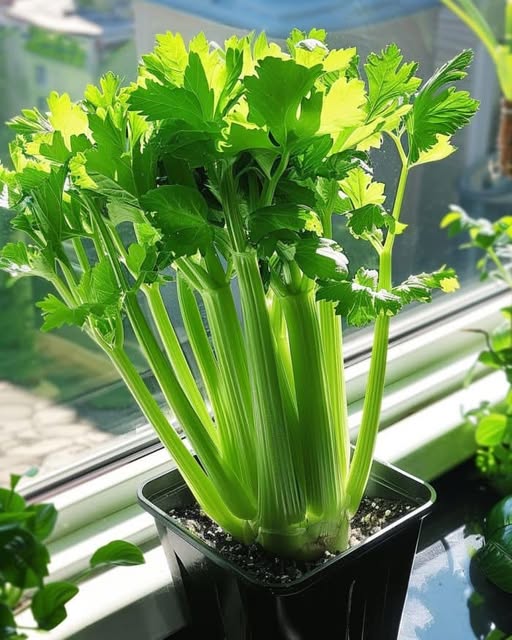ADVERTISEMENT
2. Set Up Your Pot
- Select a pot that’s at least 8 inches deep (celery has long roots), and make sure it has drainage holes. Celery prefers a well-draining, rich soil that can hold moisture without becoming waterlogged.
- Fill the pot with loamy soil, leaving about an inch from the top so the soil doesn’t overflow when you water.
3. Place the Celery in Water (Optional)
- For an extra boost, place the cut end of the celery stalk in a shallow bowl of water. Make sure the root end is submerged but the upper stalk remains dry.
- Place the bowl in a sunny spot, and after about 3-5 days, you should notice the celery beginning to sprout new leaves and roots from the base.
4. Plant the Celery in the Pot
- After the celery stalk has developed enough roots (usually when you see new shoots or roots that are 1-2 inches long), it’s time to transplant it into the pot.
- Make a small hole in the center of the pot’s soil and gently place the celery stalk in it. Cover the roots with soil, making sure that the base of the stalk is level with the surface of the soil.
- Water the plant well, making sure the soil is evenly moist but not soggy. Celery thrives in moist soil, so be sure to keep it consistently damp.
5. Care for Your Celery Plant
- Sunlight: Place your pot in a location that gets at least 6 hours of sunlight per day. Celery loves sunlight, and the more it gets, the faster it will grow. A south or west-facing window works best indoors.
- Watering: Celery needs plenty of water to stay healthy. Keep the soil consistently moist, but not waterlogged. If the soil feels dry an inch below the surface, it’s time to water again.
- Fertilizing: Celery benefits from regular feeding, especially when grown in containers where nutrients can get depleted. Use a balanced liquid fertilizer once a month to promote strong growth. Organic compost is also a good option.
6. Harvesting Your Celery
- Unlike many other vegetables, celery is a cut-and-come-again plant. This means that once the stalks are mature, you can harvest them while leaving the plant to continue growing.
- Wait until the celery stalks are 6-8 inches tall (or longer) before you begin harvesting. Cut the outermost stalks at the base, close to the root, using a sharp knife or scissors. Leave the inner stalks to continue growing and producing more celery.
- As long as the plant is healthy and watered properly, new stalks will continue to grow, and you can keep harvesting regularly. This is how you can have a never-ending supply of celery!
Tips for Growing Celery in a Pot:
- Keep the Temperature Right: Celery prefers cooler temperatures (around 55-75°F or 13-24°C). Avoid placing it in an area with hot, direct sunlight or near heat sources, as extreme temperatures can cause it to bolt (go to seed) prematurely.
- Mulching: Consider mulching around the base of your celery to help retain moisture in the soil and reduce the need for frequent watering.
- Pest Control: Celery is generally pest-resistant, but you may occasionally encounter aphids or other small insects. A gentle rinse with water or an organic insecticide should take care of them.
- Spacing: If you’re planting multiple celery stalks in a large container, make sure they’re spaced at least 6 inches apart so the roots have enough space to spread.
Why Growing Celery at Home is Worth It:
- Fresh and Organic: Growing celery at home means you control what goes into it. No pesticides or chemicals—just fresh, organic celery.
- Convenient: Having celery on hand means you can use it in salads, soups, stews, and more without having to make a trip to the store.
- Sustainable: Growing your own vegetables is a great way to reduce waste, avoid packaging, and take part in a more sustainable lifestyle.
Conclusion:
Growing celery at home in a pot is one of the easiest and most rewarding ways to have a steady, fresh supply of this healthy vegetable. With just a small amount of space, some water, and a little attention, you can enjoy the satisfaction of harvesting your own celery year-round. So, why not give it a try? Follow these simple steps, and soon you’ll have a never-ending supply of celery right at your fingertips, ready to be added to all your favorite recipes!
ADVERTISEMENT
ADVERTISEMENT
